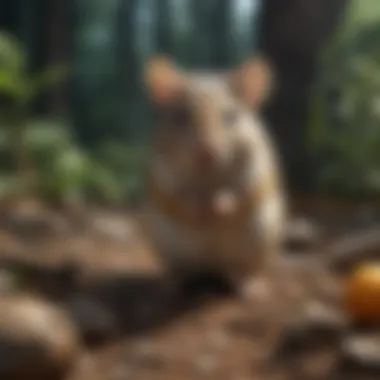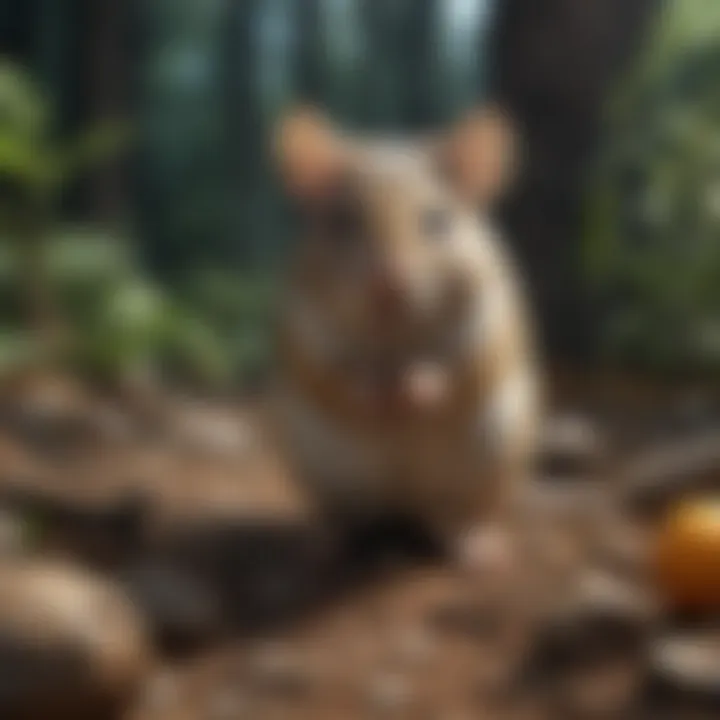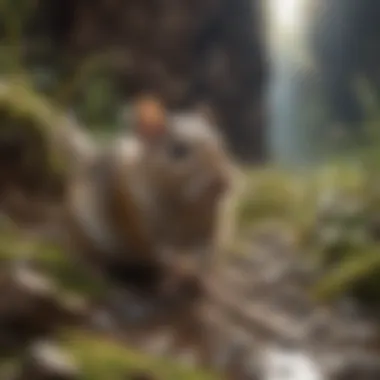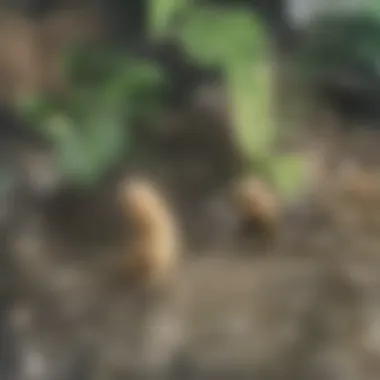Exploring the Evolution and Impact of Rodentia


Intro
Order Rodentia, housing a wide array of species, represents one of the most diverse groups within the animal kingdom. Rodents, which include familiar animals such as squirrels, mice, and rats, exhibit remarkable adaptability to various environments. Their evolutionary journey illustrates significant physiological and behavioral traits that enable their survival in diverse ecological niches. Understanding the significance of rodents is essential, considering their ecological roles and interactions with other species, including humans.
This article will unwrap the biological characteristics of rodents, examine their habitats, and scrutinize their ecological contributions. Through detailed exploration, the aim is to enrich readers' comprehension of Order Rodentia and its myriad implications in both nature and human society.
Preface to Order Rodentia
Understanding Order Rodentia is vital for several reasons. Rodents are one of the most diverse and successful groups of mammals. They contribute significantly to ecological systems and human culture. The study of rodents allows insights into evolutionary biology, ecological roles, and human impacts on ecosystems.
Historical Context
Rodents have been present on Earth for millions of years. Fossils suggest that their origin dates back to the late Paleocene or early Eocene epoch. They started as small, nocturnal creatures, evolving over time into numerous species. Their adaptability and reproductive success helped them spread across various habitats worldwide.
Different civilizations have had varied relationships with rodents. In ancient Egypt, they were often considered as symbols. In contrast, they have been demonized in some cultures due to their association with disease and filth. Understanding this historical context enriches our current perspective on these animals.
Definition and Classification
Rodents are characterized by a single pair of continuously growing incisors in each of the upper and lower jaws. This anatomical feature is crucial for their survival, as it allows them to gnaw and obtain food from hard materials. The order is classified into several families, including:
- Muridae (true mice and rats)
- Cricetidae (hamsters and voles)
- Sciuridae (squirrels)
- Castoridae (beavers)
Each family comprises various species with unique adaptations and behaviors. This classification highlights the extent of variation within the order, illustrating not just physical traits but also a range of ecological niches.
Evolutionary Significance
Rodents serve as a testament to evolutionary innovation. Their diverse forms and ecological strategies reflect resilience in the face of changing environments. They have adapted to urban spaces, forests, deserts, and wetlands, showcasing exceptional versatility.
Rodents are also important in scientific research. Due to their rapid reproduction rates and genetic similarities with humans, they are often used as model organisms in studies of genetics and diseases. This significance in research emphasizes their role beyond mere inhabitants of ecosystems.
Understanding rodents enriches knowledge on biodiversity, ecological balance, and evolutionary processes.
In summary, the introduction of Order Rodentia encapsulates a breadth of historical, biological, and ecological insights. The exploration of these aspects sets the groundwork for further investigations into their diversity, morphology, physiology, and interactions with humans.
Diversity Within Rodentia
The diversity within Order Rodentia is crucial for understanding the adaptability and ecological roles of these creatures. This section highlights the extensive variety found within rodent species, examining how this diversity contributes to their evolutionary resilience and key functions in ecosystems. The examination of different families and species demonstrates the complexity of their biology, offering insights into their adaptations, behaviors, and interactions with the environment.
Primary Families
Rodentia consists of numerous families, each exhibiting unique traits and adaptations. Studying these families gives us a deeper understanding of their survival strategies and ecological contributions.
Muridae
The Muridae family, commonly known as the true mice and rats, represents one of the largest families in Rodentia. This family is characterized by its diverse sizes and habitats, which range from urban environments to rural landscapes. Muridae is popular in this article due to its significant impact on both ecosystems and human activities. A unique feature of this family is its high reproductive rate, which allows for rapid population growth. This can be advantageous in stable environments but may lead to challenges in areas where resources are scarce and competition is high.
Cricetidae
The Cricetidae family includes species such as hamsters and voles. It is notable for its adaptability to various habitats, from forests to grasslands. Cricetidae's ability to thrive in diverse environments makes it a beneficial focus for this article. A key characteristic of this family is the presence of cheek pouches in some species, which allows them to store food efficiently. This aspect provides advantages in resource-scarce conditions, supporting survival during challenging times, though it can also lead to overconsumption when food is abundant.
Sciuridae
The Sciuridae family, which encompasses squirrels, is another essential group within Rodentia. Sciuridae is known for its distinctive behaviors, including caching food for later use. This family’s contribution to ecosystems is significant, particularly in forest environments where their foraging behaviors promote seed dispersal. Furthermore, sciurids are excellent climbers, showcasing physical adaptations such as strong limbs and a keen sense of balance. However, their reliance on specific habitats makes them sensitive to environmental changes, thus posing risks to their populations.
Castoridae


The Castoridae family includes beavers, known for their environmental engineering capabilities. Beavers are recognized for their dam-building activities, which create wetland habitats, benefiting various species. This characteristic is a compelling reason to include Castoridae in our exploration of Rodentia. Their role in shaping ecosystems cannot be understated, as they help maintain biodiversity while mitigating flooding issues. Nevertheless, the construction of dams requires significant energy and resources, presenting challenges if food sources dwindle.
Species Variation
Rodentia consists of an incredible range of species, each exhibiting variations in behavior, size, and morphology. Understanding these variations helps in appreciating the role each species plays within its ecological niche. For example, with over 2,000 species, rodents adapt to their environments remarkably well.
Geographical Distribution
Rodents inhabit nearly every corner of the globe, from urban settings to remote wilderness. The geographical distribution of rodents reveals patterns of colonization and adaptation. Their ability to thrive in varied climates is a testament to their evolutionary success. Studying how these distribution patterns affect local ecosystems provides insights into the ecological balance and potential impacts of environmental changes.
"Understanding the diversity of rodent families is key to unraveling the complex ecological roles they play in habitats around the world."
By synthesizing information on the diversity within Rodentia, we lay the foundation for understanding the ecological and evolutionary significance of these fascinating creatures.
Morphological Characteristics
Understanding the morphological characteristics of rodents is vital as it lays the foundation for comprehending their biological and ecological significance. Morphology can reveal how these animals have adapted to diverse habitats and environmental challenges. Detailed exploration of their physical features, size variations, and patterns of sexual dimorphism contributes to our understanding of evolutionary strategies and helps clarify the adaptive mechanisms at play within Order Rodentia.
Physical Features
Skull Structure
The skull structure of rodents is distinctive and plays a critical role in their overall function and adaptability. Rodent skulls feature a characteristic shape that supports their need for efficient feeding and survival strategies. A key characteristic of rodent skulls is their elongated form, which allows for an increased surface area for muscle attachment, making it easier for these animals to gnaw on various materials, such as wood and seeds.
This unique feature provides numerous advantages. For one, the robust structure supports their powerful jaw muscles. It allows rodents to forage effectively, which is essential for their survival. However, the elongated skull can present disadvantages, such as vulnerabilities in certain habitats where quick navigation through tight spaces is required.
Dental Adaptations
Dental adaptations in rodents are fascinating and crucial for their survival. A major aspect of these adaptations is the presence of hypsodont teeth, which are high-crowned, allowing rodents to maintain an effective chewing mechanism despite wearing down over time. This adaptation is particularly beneficial given their herbivorous diet, which includes tough plant materials.
The key characteristic of rodent teeth is that they continuously grow throughout their lives. This feature prevents the teeth from wearing down due to constant gnawing and feeding. However, it also requires rodents to have a consistent source of suitable materials to file down their teeth appropriately. The advantages of such dental adaptations ensure that rodents can thrive in diverse environments, allowing them to exploit a variety of food sources effectively.
Size Variations
Size variations among rodents illustrate a broad range of adaptations to different niches. Rodents can vary significantly in size, from the tiny Pygmy Mouse to the larger Capybara. This variation allows different species to occupy distinct habitats and fill unique ecological roles.
The size influences not just habitat opportunities but also reproductive success, energy needs, and predation risks. Smaller rodents often reproduce at a faster rate, while larger species may have fewer offspring but invest more in each one, showcasing various survival strategies. Understanding these size dynamics offers insight into how evolutionary pressures shape rodent populations.
Sexual Dimorphism
Sexual dimorphism in rodents is generally less pronounced compared to other mammals, but it exists. Differences between male and female rodents can often be observed in size, coloration, and behavior. Males are frequently larger, which can be advantageous in competition for mates and territory.
For example, in the case of the * house mouse*, males tend to have larger body sizes and more extensive territorial behaviors. Such traits can influence reproductive success and mating patterns, indicating how sexual dimorphism plays a significant role in rodent evolution.
Physiological Adaptations
Physiological adaptations are crucial for the survival and success of rodents. These adaptations allow them to thrive in various environments, ensuring their resilience and prolific presence across the globe. In this section, we will explore three main aspects of these adaptations: digestive mechanisms, reproductive strategies, and behavioral adaptations. Each of these components contributes significantly to the overall fitness of rodent species.
Digestive Mechanisms
Rodents possess unique digestive systems that are well-suited to their herbivorous diets, primarily consisting of plant material. They are equipped with ever-growing incisors that enable them to gnaw through tough vegetation, which is vital for their nutritional intake. The digestive system of rodents is specifically adapted to process large amounts of cellulose.
Some key features include:
- Specialized stomachs: Many rodents have multiple stomach compartments that help break down and ferment plant material effectively.
- Cecal fermentation: Rodents utilize a cecum as a fermentation chamber where beneficial bacteria aid in digestion, allowing the extraction of more nutrients.
- Coprophagy: Some species, such as rabbits, engage in coprophagy, where they consume their feces to maximize nutrient absorption. This behavior showcases their evolved mechanisms for sustaining energy levels.


Reproductive Strategies
The reproductive strategies of rodents are diverse and reflect their adaptation to various ecological niches. Rodent populations generally exhibit high reproductive rates, a significant factor contributing to their success across habitats. \nSome notable reproductive characteristics include:
- Short gestation periods: Many rodents have rapid reproductive cycles, with some species capable of reproducing within weeks of giving birth. This rapid lifecycle allows for quick population recovery after environmental stresses.
- Large litter sizes: Rodents tend to give birth to multiple offspring per litter, which compensates for high predation rates and other environmental pressures.
- Parental care: Most rodents display varying levels of parental investment, which enhances the survival rate of their young. Some species may protect their nests aggressively, while others rely on hiding their young to avoid predation.
"The rapid reproduction and adaptable parenting strategies of rodents underscore their evolutionary success and ecological importance."
Behavioral Adaptations
Rodents exhibit a range of behavioral adaptations that enhance their survival prospects. These adaptations play a significant role in how they interact with their environment, find food, and avoid predators. Some of the prominent behavioral traits include:
- Social structures: Many rodent species, such as prairie dogs and rats, form social groups that help them share information about food sources and predator presence. This social behavior can be critical for survival in risky environments.
- Foraging behaviors: Rodents have developed various foraging strategies based on their habitat. Some species demonstrate resourcefulness in seeking food, utilizing their keen sense of smell or memory to locate hidden caches.
- Burrowing and nesting behaviors: Rodents are adept at constructing elaborate burrows for shelter and safety. This adaptation not only provides protection from predators but also creates a controlled microhabitat for temperature regulation and food storage.
In summary, the physiological adaptations of rodents are a testament to their evolutionary journey. These adaptations not only enhance their survival but also enable them to occupy diverse ecological roles. Understanding these adaptations is essential for comprehending the broader dynamics of ecosystems they inhabit.
Ecological Roles of Rodents
The ecological roles of rodents are vast and highly significant. Rodents, being one of the most diverse groups of mammals, play crucial parts in various ecosystems. Their activities influence other species and the environment itself, thus shaping the biotic community. Understanding these roles is vital not only for appreciating biodiversity but also for assessing ecological balances.
Niche in Ecosystems
Rodents occupy multiple niches in ecosystems around the world. They can be herbivores, granivores, or omnivores, which allows them to adapt to various dietary sources. This adaptability reflects their ecological flexibility. For instance, some rodents like the common house mouse consume seeds, while others, like beavers, predominantly eat bark and aquatic plants. Each type of rodent contributes to seed dispersal, which is important for plant growth and forest regeneration.
Moreover, rodents have evolved coexistence strategies that benefit and influence their habitat. They can be both prey and competitors. Their presence assists in maintaining the balance among species. This illustrates their role in ecosystem dynamics.
Interactions with Flora and Fauna
Rodents interact with both plants and other animals in numerous ways. They help in pollination when they consume flowers and contribute to seed scattering. This relationship benefits plants by promoting genetic diversity and enabling new growth in different areas. The effects are often immediate and measurable in ecological terms.
On the other hand, rodents are essential for various animal species. For example, they serve as a food source for predators like owls, snakes, and foxes. This connection highlights the significance of rodent populations in maintaining predator-prey relationships. Any decline in rodent numbers can cascade through the ecosystem, impacting various species that rely on them.
Implications in Food Chains
Rodents are critical components of food chains. They form the primary food sources for a range of carnivorous animals. The abundance of rodents often correlates with the health of predator populations. In some ecosystems, specific rodents, like kangaroo rats, influence the food web by their burrowing behavior, which aerates the soil and aids in water retention.
Furthermore, the role of rodents as detritivores helps in decomposition processes. They break down organic materials, contributing to nutrient cycling within ecosystems. This not only sustains plant growth but also supports various microbial processes vital for ecological health.
"The health of an ecosystem can often be gauged by the presence and diversity of its rodent population".
Rodents and Human Interaction
Understanding the interaction between rodents and humans is essential. This topic focuses on the various ways rodents impact human life, from economic implications to cultural relevance. As one of the most adaptable order of mammals, rodents influence agriculture, health, and even social practices across the globe. Thus, examining this interplay offers insights into both the challenges and benefits of coexisting with these creatures.
Economic Impacts
Rodents play a dual role in economic contexts. On one hand, they can be detrimental to human activities, particularly in agriculture. Species like the house mouse and the Norway rat can create significant damage to crops and stored food. In the U.S. alone, it is estimated that rodents cause billions of dollars in losses annually due to their feeding habits and the contamination of food supplies.
On the other hand, some rodents are invaluable. For example, the domesticated rabbit is bred for meat and fur. Additionally, activities such as ecotourism increasingly focus on unique rodent species found in specific ecosystems.
- Key economic impacts include:
- Crop damage and food spoilage.
- The market for pest control and rodent-resistant crop varieties.
- Contributions of certain rodent species to local economies through tourism.
Public Health Concerns


Rodents are often vectors for various diseases, raising significant public health concerns. Pathogens carried by rodents can transmit illness to humans, resulting in outbreaks. For instance, the hantavirus and leptospirosis are linked to rodent contact, presenting serious health risks. Lack of control measures can lead to severe consequences, especially in urban areas where rodent populations thrive.
Preventive health approaches must include sanitation efforts and community education to minimize these risks.
"Rodents are not merely pests; they are living organisms that can affect human health significantly."
Cultural Significance
Culturally, rodents hold a unique position across different societies. They appear in folklore, literature, and in some cases, even religious contexts. The rat is often viewed negatively in many cultures, symbolizing filth or disease. However, in contrast, in some cultures, certain rodent species are revered. For example, the capybara is celebrated in some South American cultures for its friendly nature and is often associated with social gatherings.
Aspects of cultural significance include:
- Folklore and myths featuring rodents.
- The role of rodents in children's literature and cartoons.
- Their importance in rituals and festivals in certain cultures.
In summary, the relationship between humans and rodents is multifaceted. While economic and health challenges prevail, cultural aspects provide a deeper understanding of their significance. Recognizing these interactions can inform better management strategies and educational efforts.
Conservation Status
Conservation status is a crucial aspect of understanding the long-term viability and health of rodent populations. It helps to inform conservation strategies, funding priorities, and research directions. Rodents, being the largest order of mammals, hold significant ecological roles. They affect various ecosystems and interact with both fauna and flora, making their conservation critical for maintaining biodiversity. The ongoing threats faced by these species necessitate an examination of their conservation status.
Threats to Rodent Populations
Several factors contribute to the decline of rodent populations worldwide. These threats include habitat loss, climate change, predation pressures, and human activities.
- Habitat Loss: Urbanization and agricultural expansion fragment natural habitats, making it difficult for rodent species to thrive. Deforestation reduces nesting sites and food resources.
- Climate Change: As temperatures rise, rodent behaviors and distributions may shift, potentially leading to mismatched ecological relationships.
- Predation Pressures: Non-native species, like cats and dogs, threaten native rodent populations. These introduced predators may disrupt the balance of ecosystems.
- Human Activities: Rodents face persecution due to their association with crops and disease transmission. This results in culling and poison use, further endangering their survival.
Conservation Efforts
Various strategies have been employed to address the decline in rodent populations. These efforts are pivotal in reversing negative trends and restoring ecosystems.
- Habitat Restoration: Initiatives aim to restore degraded habitats through reforestation or wetland rehabilitation, benefiting rodent species' ecosystems.
- Legislation: Laws protect endangered rodents, guiding conservation efforts. The Endangered Species Act in the United States serves as a form of regulation guiding protection measures.
- Research and Monitoring: Studying rodent populations helps understand their ecology, behavior, and responses to changes in their environment. This information is necessary for effective conservation efforts.
- Community Engagement: Involving local communities in conservation efforts creates awareness and promotes coexistence with rodent species. Programs focus on educating people about the ecological importance of rodents.
Future Considerations
Looking ahead, effective conservation of rodent populations demands a multifaceted approach. Several key considerations should shape future efforts.
- Integrating Climate Resilience: Conservation strategies must account for climate change impacts. This includes protecting ecosystems that are resilient to climatic shifts.
- Research Investment: Funding should support research on lesser-known rodent species and their roles in ecosystems, contributing to a more comprehensive understanding of their biology.
- Creating Corridors: Developing ecological corridors allows rodent species to move between habitats, promoting genetic diversity and enhancing population resilience.
- Global Cooperation: Addressing threats to rodent populations requires collaboration across borders. International efforts can improve conservation outcomes through shared knowledge and resources.
Maintaining rodent populations is essential for ecological balance. Their decline can have ripple effects throughout ecosystems.
In summary, understanding the conservation status of rodents is vital for ensuring their future. With strategic efforts and research, it is possible to mitigate threats and promote the survival of diverse rodent species across habitats.
End
The topic of the conclusion serves as a vital component to the overarching narrative within this article on Order Rodentia. This final section encapsulates the key insights gained from our exploration, reinforcing the significance of the research and discussions presented throughout. Drawing connections between various families, ecological impacts, and the relationship between rodents and humans, this conclusion crystallizes the relevance of rodents within broader ecological and evolutionary frameworks.
In summarizing the key findings, it is crucial to highlight the diverse biological traits and adaptive strategies that have allowed rodents to thrive in a variety of habitats. Their ecological roles showcase how they contribute to nutrient cycling and as prey in food chains. By addressing these elements comprehensively, the conclusion emphasizes the multitude of considerations surrounding rodent conservation efforts in the face of increasing threats to their populations.
Furthermore, the conclusion encourages acknowledgment of the integral part rodents play in ecosystems while advocating for their conservation. This section also supports initiatives to foster research aimed at understanding the impacts of anthropogenic factors, like habitat destruction and climate change, on rodent populations.
Summary of Key Findings
- Diversity: Order Rodentia includes a vast array of species, with families such as Muridae, Sciuridae, and Cricetidae exhibiting significant morphological and behavioral diversity.
- Adaptations: Rodents possess unique anatomical features, particularly in their dental structures and digestive mechanisms, allowing them to exploit a wide range of food sources.
- Ecological Roles: They serve important roles in ecosystems as consumers and prey, contributing to nutrient cycling and supporting food web dynamics.
- Human Interactions: The relationship between rodents and humans is multifaceted, encompassing economic implications as well as challenges related to public health and urban environments.
- Conservation Status: Many rodent species face threats due to habitat loss, predation, and diseases, necessitating focused conservation efforts to ensure their survival in changing environments.
Future Research Directions
Future research can benefit from a deeper exploration into several areas related to Order Rodentia, including but not limited to:
- Impact of Climate Change: Understanding how climate fluctuations affect rodent behavior, reproduction, and habitat distribution can provide insights into potential conservation strategies.
- Urbanization Effects: Investigating how urban environments alter rodent populations and behaviors can offer solutions to mitigate negative human-wildlife interactions.
- Genetic Studies: Advanced genetic research may uncover evolutionary relationships and historical population dynamics within various rodent families.
- Health Studies: Examining the transmission of zoonotic diseases from rodents to humans, particularly in urban settings, will be essential for public health strategies.
- Conservation Impact Assessments: Evaluating the effectiveness of current conservation efforts will help in adapting strategies to improve rodent preservation in their natural habitats.
By directing research towards these areas, we can enhance our understanding of rodents and facilitate their protection as integral parts of the biosphere. The conclusion serves as a springboard for future discussions, research endeavors, and conservation initiatives to ensure the sustainable existence of the order Rodentia.







